Giugiaro’s Legacy: A Watch And A Car – A Different Perspective On the Reissue Of an Iconic Quartz Chronograph by Seiko
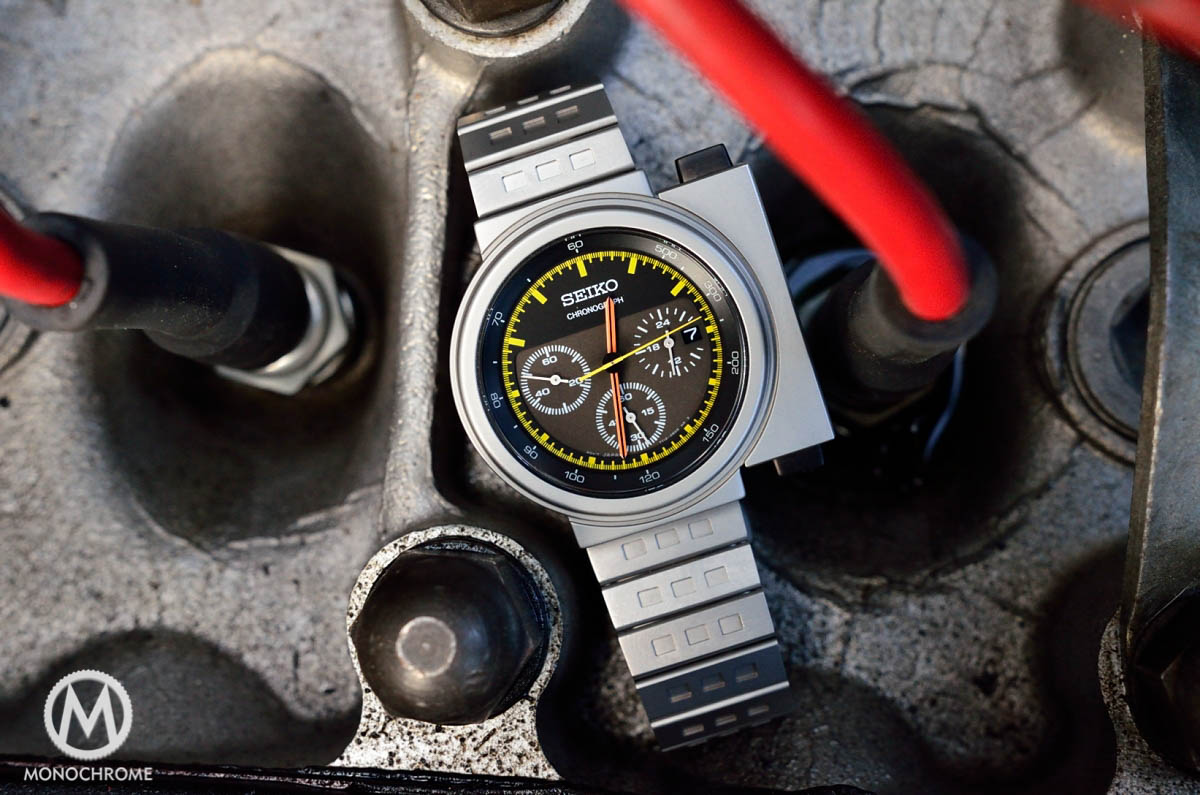
Today we’re going to have a look at two style icons, and one of them is a quartz watch! You know us, we hardly ever focus on timepieces with a quartz regulator, however this is one that shows in a very novel way that there are many possibilities in the design of a wrist watch. In the final months of 2015 Seiko re-issued one of its iconic quartz chronographs that was originally introduced in the early 1980’s and became famous in a Hollywood movie. This is a chrono designed by one of the greatest industrial designers of all time, Giorgetto Giugiaro. He was instrumental in creating iconic products and cars. Therefore in this article we will review this new re-issue from Seiko and we will examine its relation with its iconic predecessor; in parallel we will inspect one of Giugiaro’s greatest car designs through the eyes of its owner, Mr. Akrivos, a vintage watch collector and an Alfaholic extraordinaire.
Some words about Industrial Design
Industrial design studies function and form—and the connection between product, user, and environment. Generally, industrial design professionals work in small-scale design, rather than overall design of complex systems such as buildings or ships. Industrial designers don’t usually design motors, electrical circuits, or gearing that make machines move, but they may affect technical aspects through usability design and form relationships.
This form of design surrounds our everyday life. It may not have crossed our mind that a person drew up the plans for an escalator that we ride in the mall, edited the plans of the computer from which we work each day, designed our phone, our watch, our car, our toothbrush. A person or a team put effort in order to think how to create from abstract a product’s form that must be manufactured through mass production. This product must provide solutions for problems of form, function, usability, and ergonomics. The truth is, industrial design’s influence is profound. Designers have moved and shaped the world we are a part of, from the most complicated design, to the simplest one.
A small list of famous industrial designers might include Alvar Aalto, who designed a significant number of household items, such as chairs, stools, lamps, a teacart, and vases. Raymond Loewy a prolific American designer who is responsible for the Royal Dutch Shell corporate logo, the original BP logo, the PRR S1 steam locomotive, as well as Schick electric razors, refrigerators, short-wave radios, and a complete line of modern furniture, among many other items. Richard A. Teague, who spent most of his career with the American Motor Company and originated the concept of using interchangeable body panels so as to create a wide array of different vehicles using the same stampings. Philippe Stark who established an international design company that mass-produced consumer products. Today, we see his design and influence in furniture, appliances, toothbrushes, staplers and tableware. Dieter Rams who as the head of the consumer products for Braun company introduced his design method with the phrase “Weniger, aber besser,” which translates to “Less, but better.” Last but not least, David Mellor who by designing cutlery also helped design street lighting, public seating, trash bins and traffic lights.
Giugiaro: Seiko & Aliens
Giorgetto Giugiaro is of course on that list. His point of focus was mainly to design cars, another mass-produced object that changed our lives. In 1968 he founded Ital design with Aldo Mantovani and presented an innovative formula for the car industry: a company able to provide creativity, engineering, construction of pre-series prototypes, production start-up assistance and all the support required to put a new product into production. Giugiaro was named car designer of the century in 1999 and inducted in the automotive hall of fame in 2002. He was responsible for the design of 14 Alfa Romeos, as well as the Lotus Esprit, the Lancia Delta, the DeTomaso Mangusta, the BMW M1, the DeLorean DMC-12, the Ferrari 250 GT SWB, Fiat’s Panda, Uno and Punto, while his major accomplishment was the design of the VW Golf in 1974.
Giugiaro designed in parallel a variety of products (furniture, firearms, motorcycles). His most famous work outside the automotive industry has been made for two Japanese industrial giants. The first collaboration came with Nikon in 1980. The mythical Nikon F3 is his creation and with this model he single-handedly moulded the company’s image and gave the Japanese a few lessons on how to handle and package a world-class product. From that point onward he was responsible for the design of all Nikon F professional cameras. In addition, he also helped another Japanese firm called Seiko.
In 1983 Seiko introduced the first-ever analog quartz chronograph movement, the 7A28. Most unusually, the mechanism was fully jeweled (15), used no plastic parts, and allowed for simple regulation by the user. A separate motor was provided for each indicating function, and the button at 10 o’clock temporarily stopped the chronograph hands’ motion as actual timing continued, providing an odd sort of “split-second” function. Best of all, while the main chrono-seconds hand moved at the typical quartz once/second, the hand within the subdial at 3 o’clock raced along at a most entertaining 20 steps per second, (although it is labeled “1/10s”). With its robust construction, the 7A28 calibre proved to be an exceptionally tough watch and the British Royal Air Force bought over 11,000 of them to equip pilots & navigators.
In parallel at the same time Giugiaro was commissioned by Seiko to create an alternative design for this analogue chronograph calibre. The partnership flourished resulting in a series of four designs, two analogue and two digital that were immediate and lasting successes when they were launched in 1983. The new collection had to appeal on young motorists therefore Giugiaro started from the ergonomics. Each design had a distinguishing feature but all focused on enhancing user experience. The digital had an adjustable strap to convert the watch into a professional instrument that could be fitted on bicycle handlebars or steering wheel spokes, while the other one had an angled face to ensure the watch could be seen while driving without having to turn the wrist. Perhaps the best example for its functionality was that the legendary Ayrton Senna had worn one, almost religiously at the start of his career.
The two analogues had also unique design features based both on an asymmetrical design ethos. The first (Ref 7A28-6000) had an offset casing in relation to the strap to ensure it does not interfere with shirt or jacket cuffs, while the other one (Ref. 7A28-7009) had a unparalleled configuration of function buttons (start/reset/stop) which were always on grasp despite the angle of the watch in relation to the wrist. The Speedmaster Sports 100 series as Seiko named them, were a huge boost for the imago of Seiko. They managed to combine the traditional appeal of the analogue watch with the dynamism of the digital-era counterpart. Giugiaro’s aesthetic and design sensibilities were particularly well suited to mass and popular culture despite the fact that we can see a similar shaped watch designed by Roger Tallon in 1974 (Mach 2000 by Lip). They were designs highly functional, unusual and ground breaking and that reflected the 1980’s era, however they are still classically futuristic even after 33 years.
This futuristic sci-fi design was what made James Cameron to use both of these watches in his 1986 film Aliens. The one (Ref 7A28-6000) was worn by the android Bishop played by Lance Henriksen while the other refinished in a gun-metal/blasted silver color instead of black was worn by the Ellen Ripley played by Sigourney Weaver (Ref 7A28-7000). From that point both these models became quite famous especially from collectors of the Alien films franchise. Seiko re-issued the ‘Bishop’ as the collectors named it in 2013 while this year they decided to release the ‘Ripley’.
Giugiaro and the Car – A Few Words by its Owner
In 1968 Alfa Romeo approached the designer from Piemonte in order to create the successor of the already hugely popular Giulia Sprint GT (the 105 series cars). It took almost six years for the design finalization which was rather far away from the curvaceous silhouette of the Giulia coupés: this was the wedge era after all. A couple of details were thus borrowed from the Alfa Romeo Iguana concept car of 1968 resulting in a visually balanced, yet purposeful enough shape. The beauty of the Alfetta GT, this was the name of the new car honoring the Alfetta 159 F1 of the early 50s, wasn’t just skin-deep: the automobile featured a 50/50 front/rear weight distribution with the rear disc brakes mounted inboard in order to achieve that goal. Initially the car was available only with the Nord 1750 engine but two years later this option was dropped in favour of a 2-liter engine and so the GTV was born: “ V” stands for Veloce, meaning “fast” in Italian. Restyling came in 1980 with the plastic bumpers taking the place of the chrome ones while a couple of months later the GTV6 appeared featuring the characteristic bulge on its bonnet, under which the all new 60 degree V6 motor with 160hp potential was housed.
Growing up in the 80s I must admit that the aggressive shape of the GTV seemed to have really stuck in a certain corner of my mind, a corner with vivid memories of both the cars and the people who drove them. This was a rather exclusive automobile leaning towards the expensive side, while simultaneously possessing beauty, performance and charisma that inspired spirited drivers of the era to talk about these cars with respect. I remember my father, a great admirer of GT-coupé aesthetics and a true lover of fine automobiles, to point out to his ten year old son the way the GTV appeared to “sit” on its rear wheels, when under power. This was the star coupé of its day: you could see Al Pacino driving an early GT version in “Bobby Deerfield” or Roger Moore in a GTV6 famously doing some stunts while being chased by police BMWs in “Octopussy”. For an added touch of class your choice could be Charlotte Rampling owning a red GTV in the Jacques Deray’s adaptation of the Robin Cook novel “He died with his eyes open”; and remaining in France, even Christophe Clark, of porn-star-fame, could not resist the sexiness of one: a second series grey GTV 2.0.
You have probably understood by now that the writer of these lines is one of those who fell under the GTV’s magic spell. Anyone who appreciates not only the angular elegance of its form but also the glorious sound of open carburators with GTA type racing trumpets, will instantly smile with consent. The long awaited acquaintance and subsequent purchase took place 20 years ago and a lot has happened since then. You see, the goal was a rather twisted one: NOT to have a car which would spend its time parading on weekends BUT to build a street-able, period correct, yet “souped-up”, version of the GTV. A car that would remind of the times when gentlemen raced the same cars they drove every day.
The two liter engine was extensively reworked: high lift racing camshafts, bigger valves, ported and gas-flowed cylinder head, hi-compression pistons, special racing conrods, rare Dellorto 45 “power-jet” carburators with GTAm racing trumpets, larger diameter exhaust manifold, oil cooler and much, much more. The list went on and on as the path towards completion of what I like to call “a passionate man’s vision”, led to more and more improvements: larger diameter split disc brake rotors with 4-pot callipers and light alloy hubs for the front end (much like the Group 2 cars of the era), ultra rare short steering rack (2.2 turns instead of the 3.6 turns original), custom made close ratio gearbox with limited slip differential, a track day focused interior etc etc. External appearance though remained largely untouched, apart from the nowadays scarce Ronal Turbo wheels and the GTV6 bonnet.
The result is a car that feels fast and responsive in a precious, old-fashioned way and although “only” a 2 liter, it races GTV6s with ease (it is lighter and more powerful after all). At the same time the car manages to retain a rather great part of its GT character and charisma. A blend so greatly missed today by a whole generation of drivers. Of course I do understand that this is surely a never-ending project, as is with all similar projects after all. Was it pretentious to achieve my goal? You bet it was. Have I regretted building it the way it is today? Not for the slightest moment.
The 2015 Limited Edition Reissue Seiko Sced035
Do not be afraid, the 1980’s-futurist vibe appears to be intact with the new reissue by the Seiko. The biggest change is perhaps the heart of the watch, and the calibre inside. In the reissue we find the modern 7T12 calibre, which is a mass-produced movement with plastic parts. It’s lower-spec than the 7A28, with 1/5 second chronograph timing rather than 1/10, however it does have a split-seconds feature as the original. All you have to do is press the start button and then the reset button. The measurement stops. After the desired elapsed time passes you simply press again the reset button and the calibre resumes the timing of your main event. The calibre 7T12 is an acceptable movement chosen by Seiko, probably in order to keep the cost of the watch as low as possible, however it is more than you need. It has a five-year battery life and its extremely accurate.
The design of the 7A28-7000 and the SCED035 is also slightly different. The reissue lacks the crown and pusher on the left side of the case. In addition the dial layout is different as well. Here we find at the 9pm sub-dial the constant seconds while the 6pm sub-dial is the minute hand for the chrono (1Hr). Finally for me the biggest improvement is that the 3pm sub-dial incorporates a 24Hr counter and a neatly aperture for the date; a much more practical approach. Everything else about the watch, including the bracelet, remains the same. The case measures 42.2mm by 41.8mm. It is 10.8mm thick and it boasts water resistance to 100 meters. The case appears to be very well made, its stainless steel and I reckon its not blasted but it is painted. In my view Seiko did a very nice job both on the 035 and the 037, which is not PVD but painted as well.
With its highly futuristic but very ergonomic design the new reissue is a supreme conversation piece. Everyone, I mean everyone asked me what is this thing on my wrist. Movie freaks recognized it and started to mumble about the movie. Fashionistas asked where to buy this cool watch. Fellow collectors with a clear disgust to any quartz-controlled watch told me that this could be the only exception to the rule. Relatives and friends noticed its design and were totally surprised when I told them that the watch was designed 33 years ago. In parallel everyone was amazed as to how comfortable and ergonomic is the watch on the wrist. The light and very distinctive bracelet (reminds me of a caterpillar track) makes the wearing experience a joy since the watch is very light. The identifiable rectangular section were the pushers are placed does not irritate the wrist or do not hinder any movement whatsoever. This Seiko chronograph has a unique character shaped by its ingenious design and its iconic role in a Hollywood movie. It’s not the Lange & Sohne Datograph but nevertheless it’s a very cool, Limited Edition and cheap quartz chrono that proves that money has nothing to do with style and knowledge, especially when we have to talk about watches.
Epilogue
Both the Alfetta GTV and this Seiko chronograph we examined came from the mind and the pen of one of the greatest industrial designers of all time. Both of these products designed and built in order to fulfill a role in our everyday lives but in parallel they manage, I dare to say, to put a smile on the face of their owners. Both are iconic and also classic, perpetual and highly relevant in our trash/throw-away society. The Alfetta is a thing of beauty on four wheels. Its angular lines, its masculine shape, its growl makes you think that this car has a soul. Purpose built and very sexy, you see it moving and immediately you start wondering why modern cars have not anymore the flair of this beast.
The Seiko also is a wristwatch that seeks your attention. You want to look at it. It is an excellent conversation piece. It’s highly practical. Its unobtrusive, honest and long lasting as all great products are. It might be not worth much from a horological point. It’s not an Omega Speedmaster, or a Breguet type XX. This Japanese chrono however manages to reclaim all that it lacks by its sheer design characteristics. It is useful, innovative and an understandable product after the first encounter.
One of the Ten Principles of Good Design given by Dieter Rams is that a product must have a good design aesthetic. “The aesthetic quality of a product is integral to its usefulness because products are used every day and have an effect on people and their well-being,” wrote Mr. Rams. Both car and watch have this quality in spades. The Alfetta is considered one of the greatest cars Alfa-Romeo built while Alex Newson of the Design Museum considers this humble Seiko Chronograph one of the Fifty Watches That Changed the World in it’s book. Nuff Said….
The grey SCED035 and black SCED037 watches are limited to 3,000 pieces each, and will set you back ¥32,000 (about $260) and ¥36,000 ($292) respectively. They are both available only for the Japanese Domestic Market.
A big Thanks to Mr. Zissis E. Akrivos the gentleman with a vision and the owner of this Great Alfetta GTV and also a big Thanks for Mr. Katshuhisa Higuchi for helping me find and the watch.
Bibliography
- For a definition on what constitutes Industrial Design please check: https://en.wikipedia.org/wiki/Industrial_design
- Five Industrial Designers that Changed our World: http://www.impulseproductdevelopment.com/five-industrial-designers-changed-world/
- A Few Words about Seiko from Itad Design’s site from: http://www.italdesign.it/en/projects/seiko-speedmaster-2014/
- A more in Depth view about Seiko’s 7A28 Calibre from: http://ninanet.net/watches/others13/Mediums/mseiko7a28.html
- In order to learn more about Seiko Reissues from: http://grail-watch.com/2015/12/01/seiko-sced-modern-reissue-1980s-aliens-chronographs/
- Newson, Alex. Fifty Watches that Changed the World. Design Museum Fifty Series. (Conran Octopus Ltd, London, 2015)
- Rams, Deiter. Ten Principles of Good Design. Please Check: https://readymag.com/shuffle/dieter-rams/

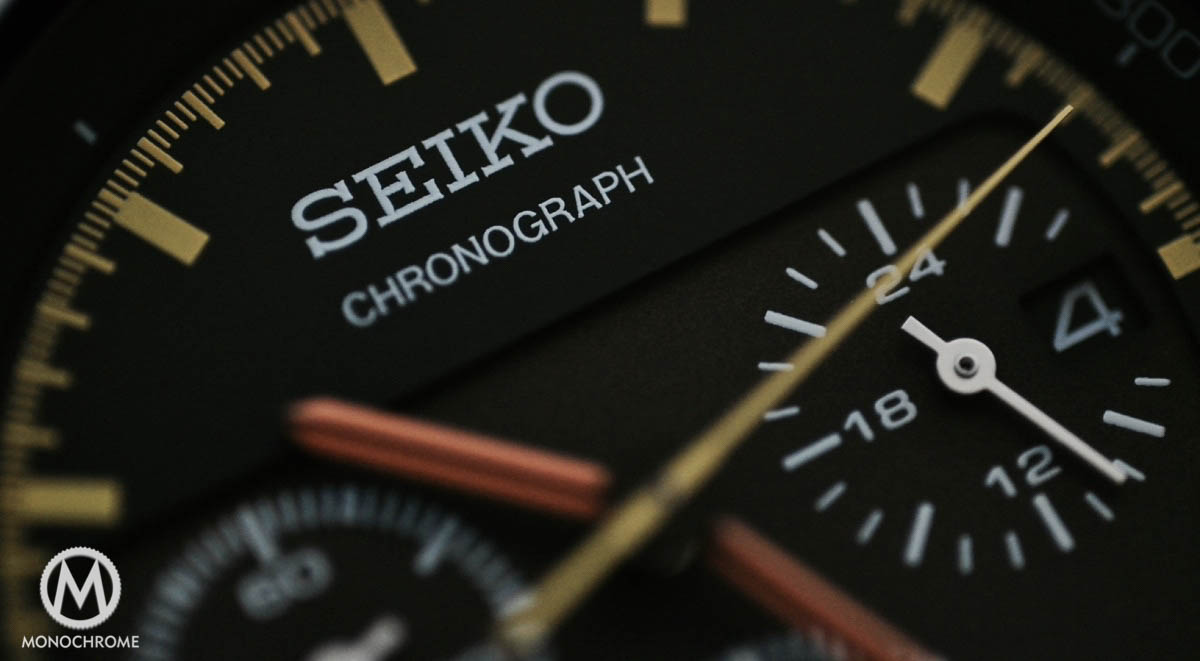
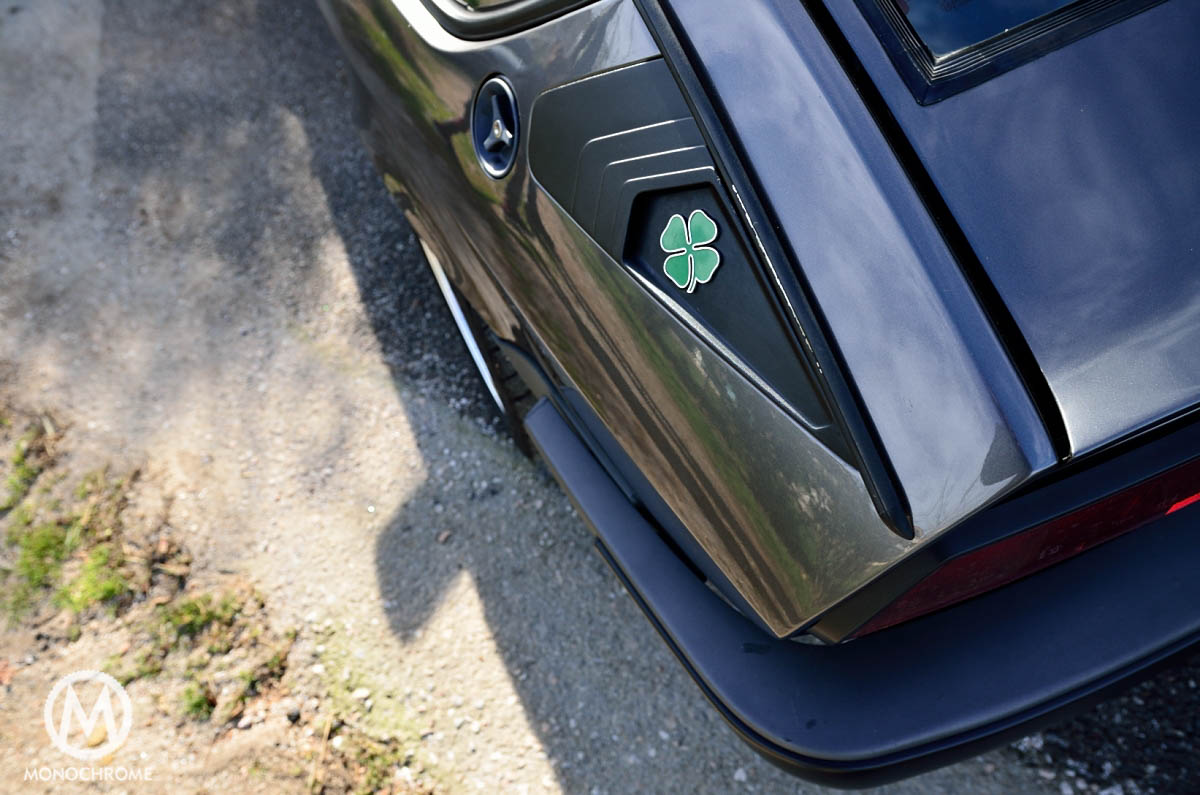
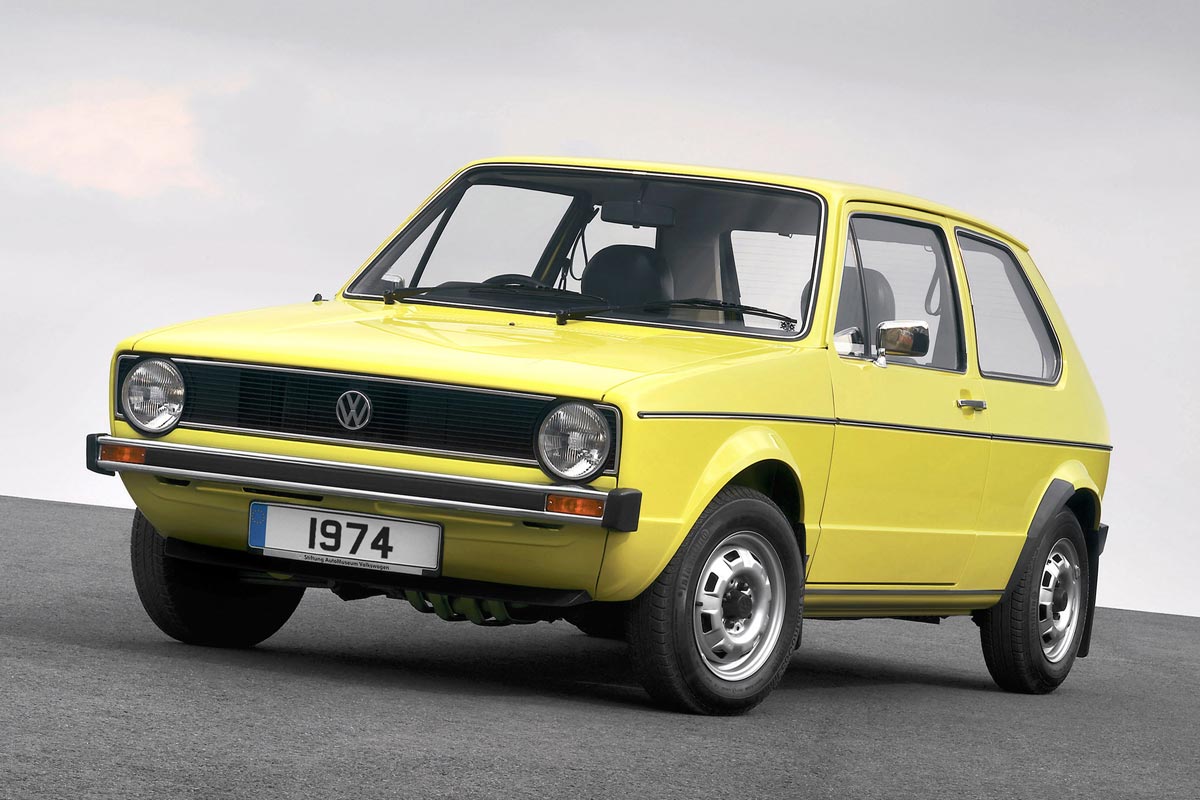

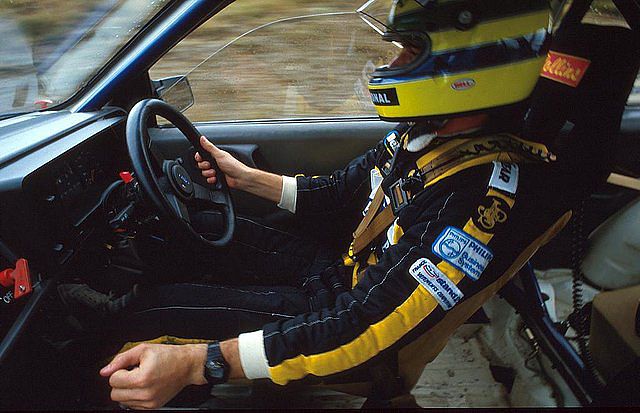
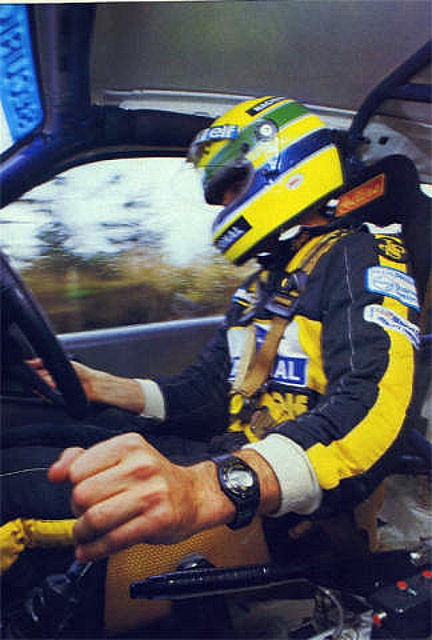
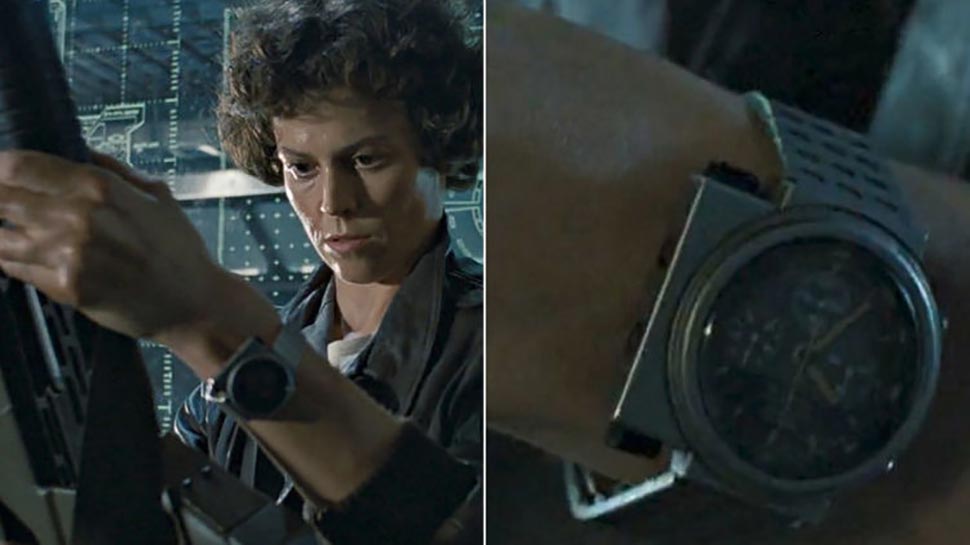
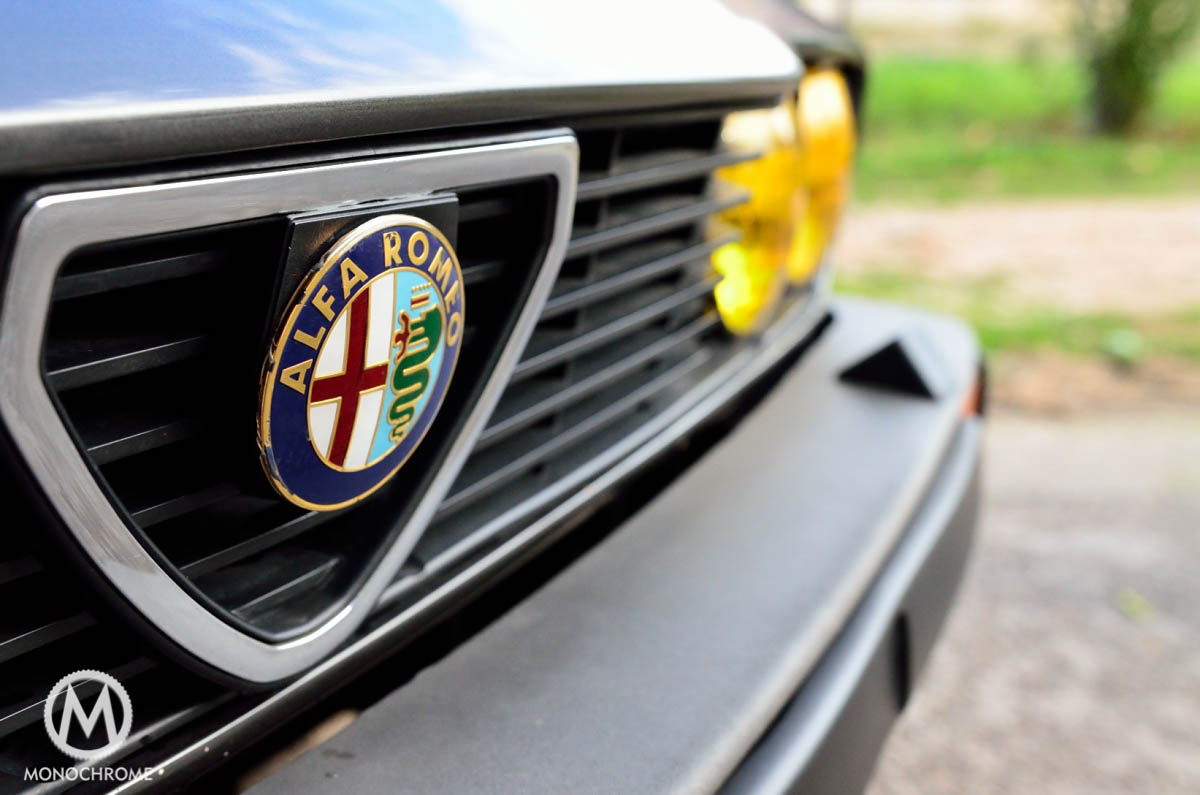
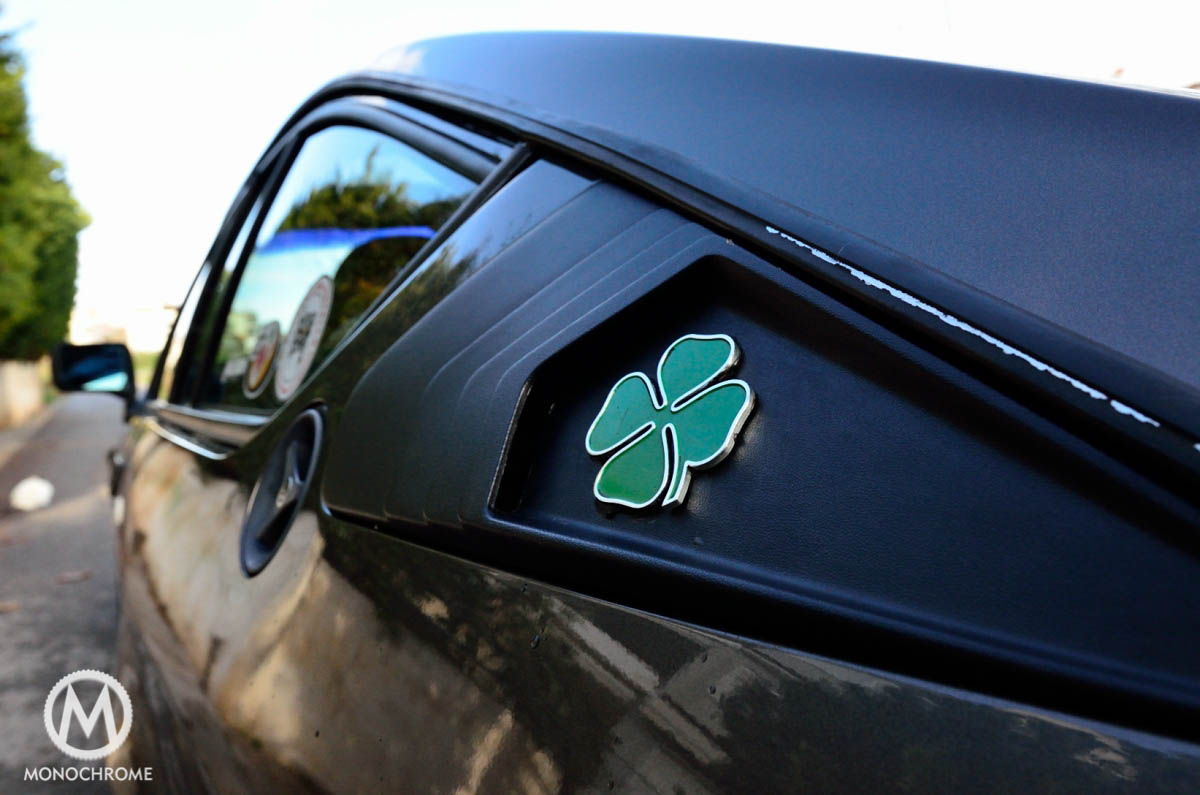
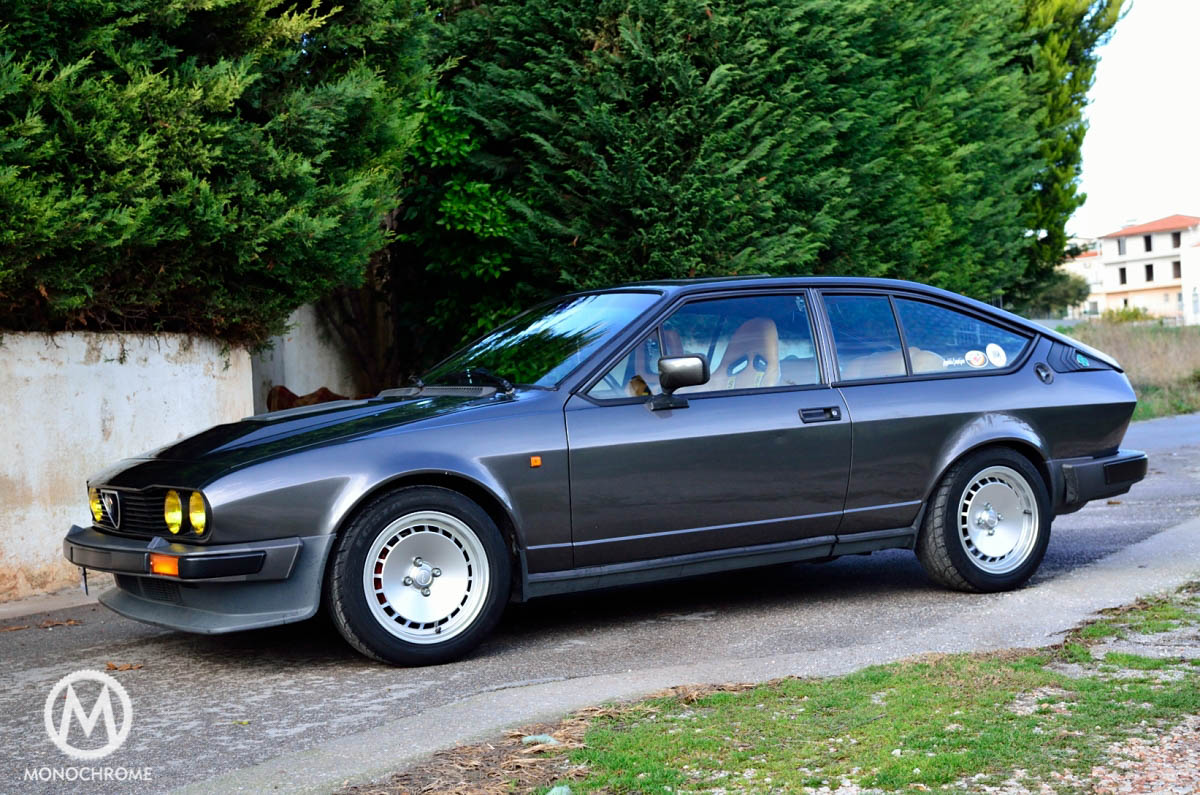
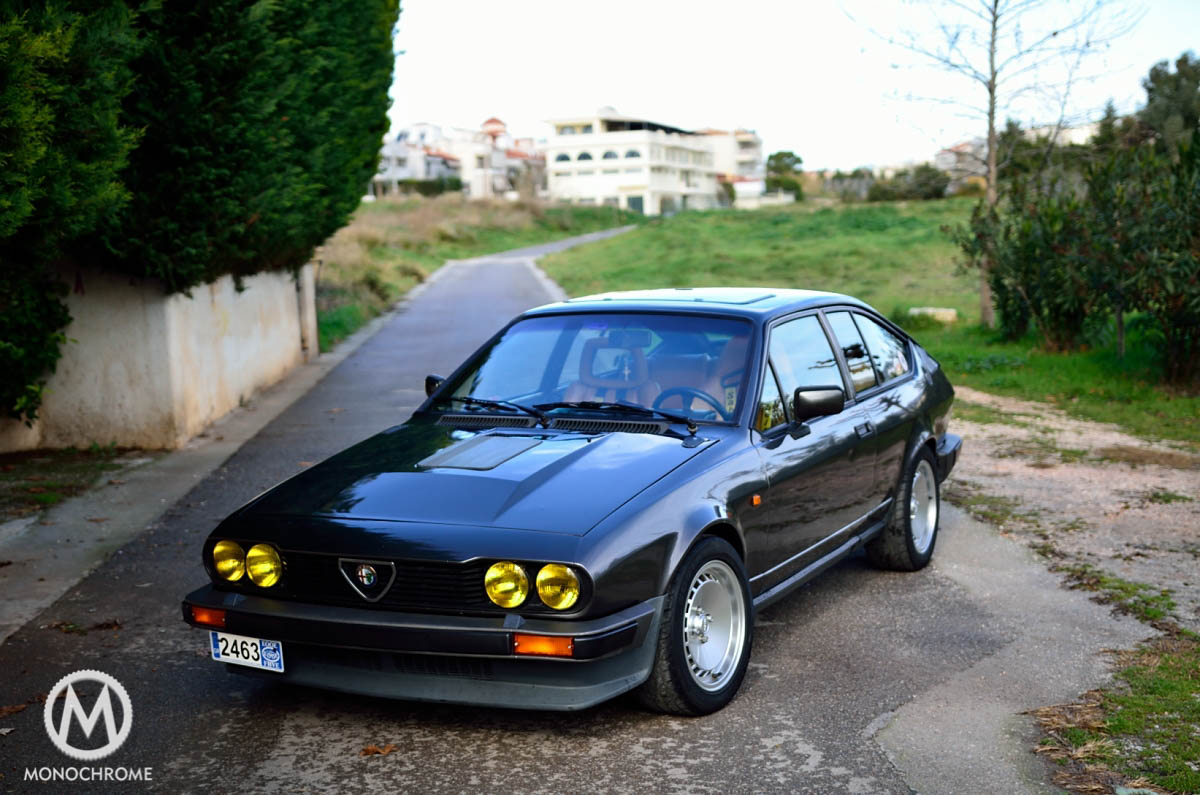
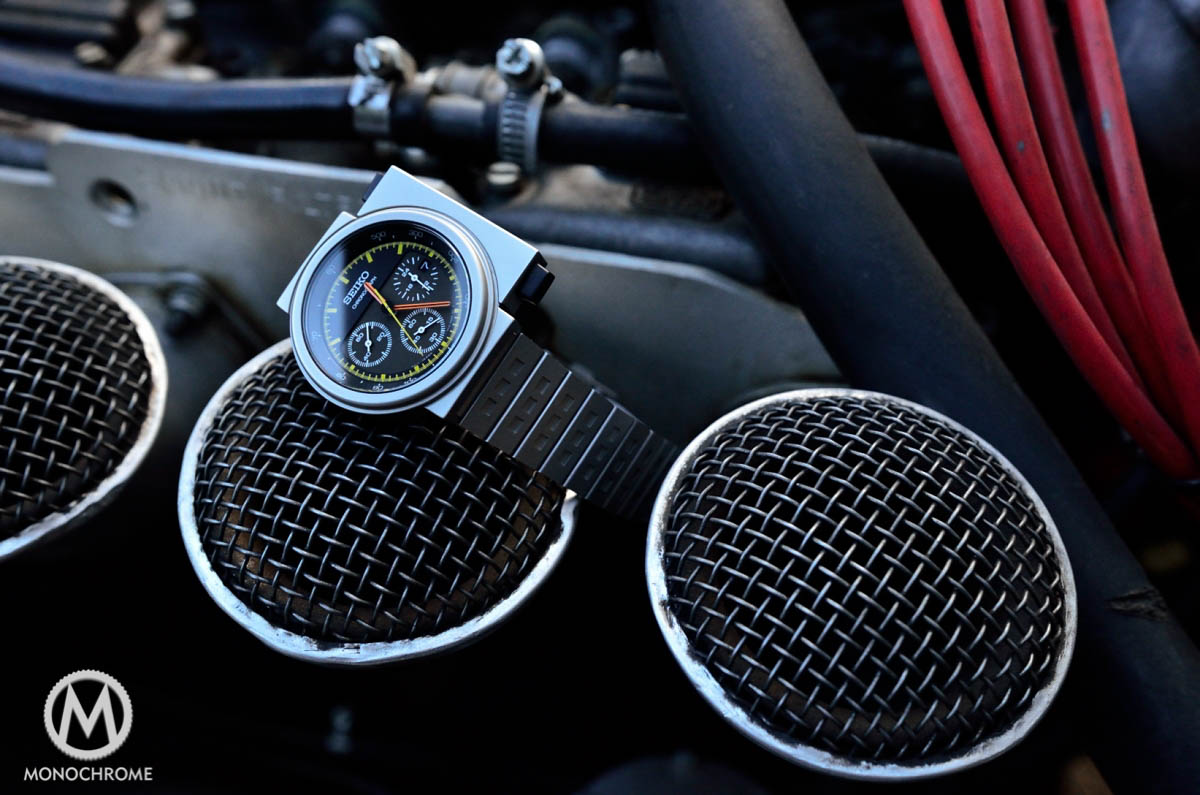
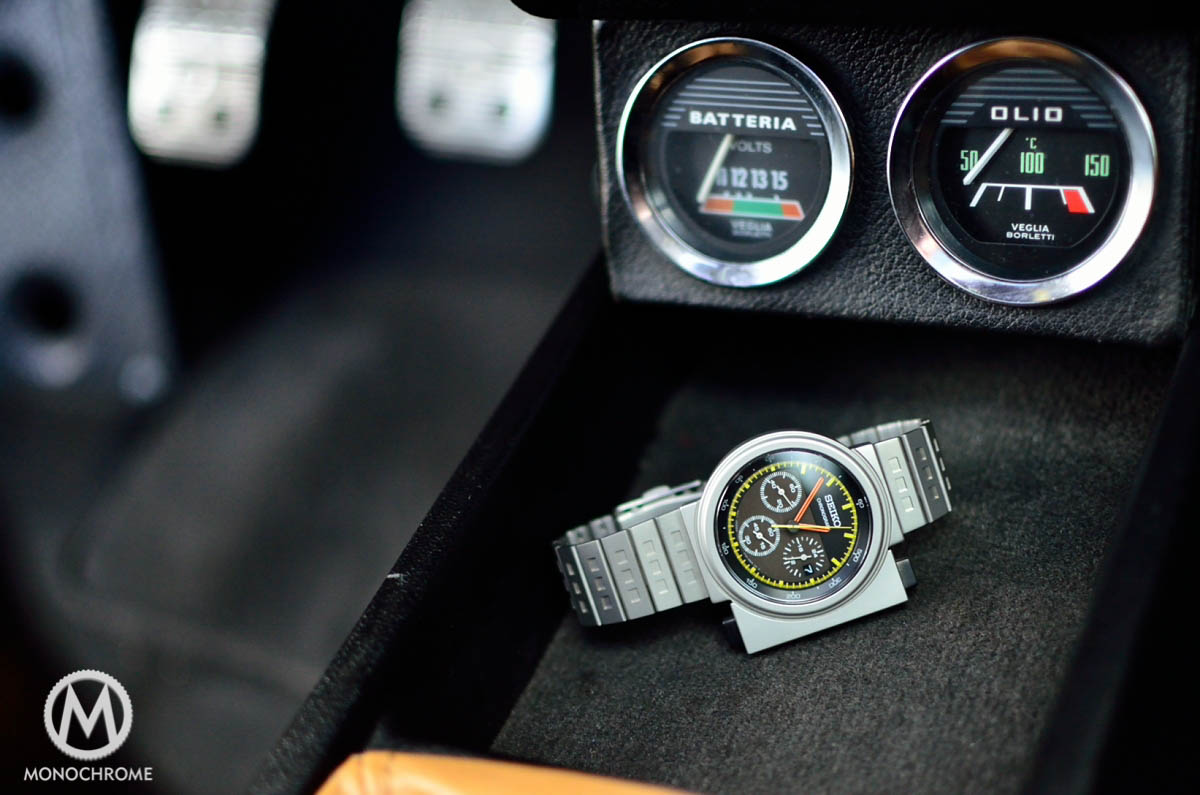
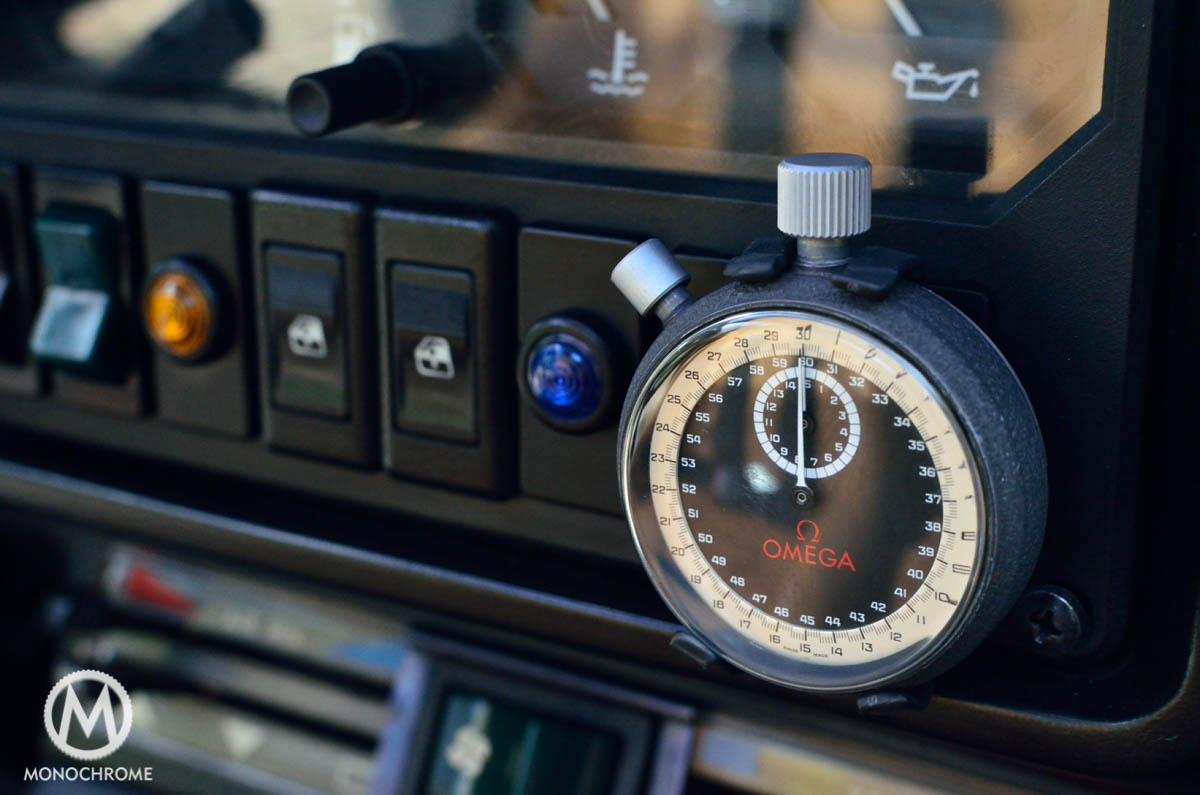
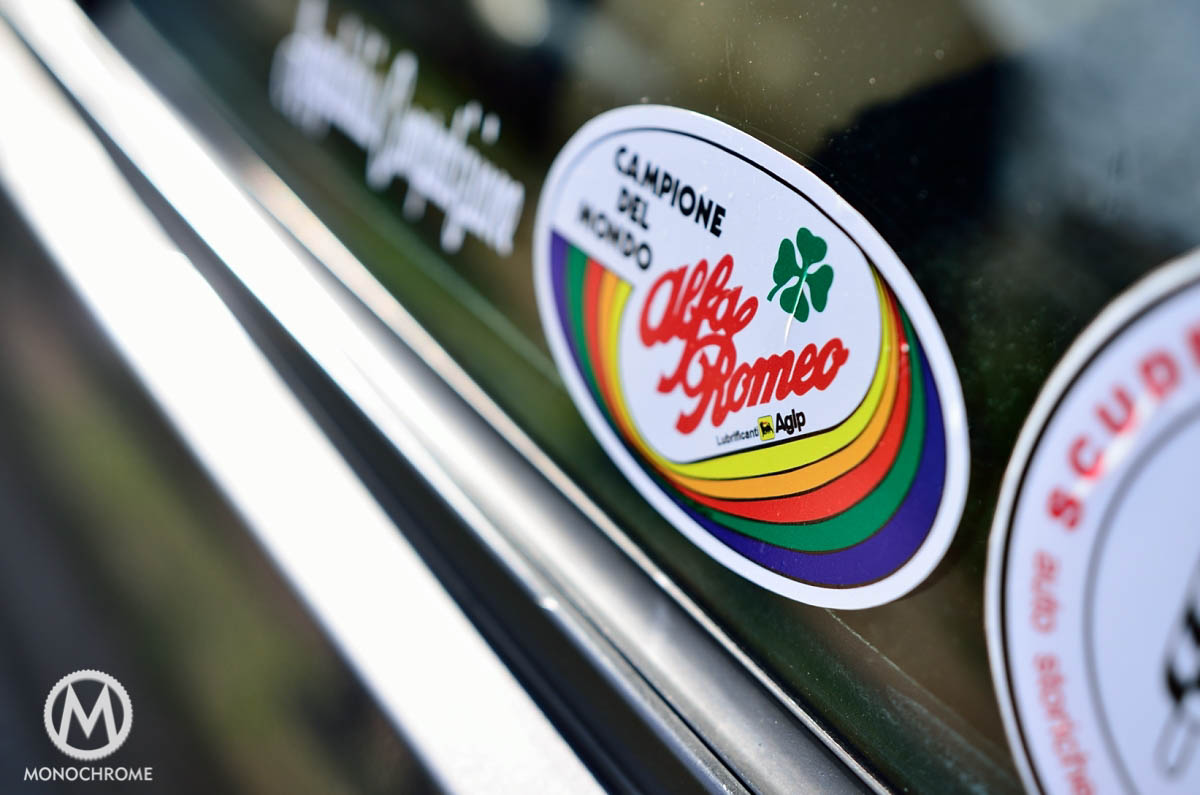
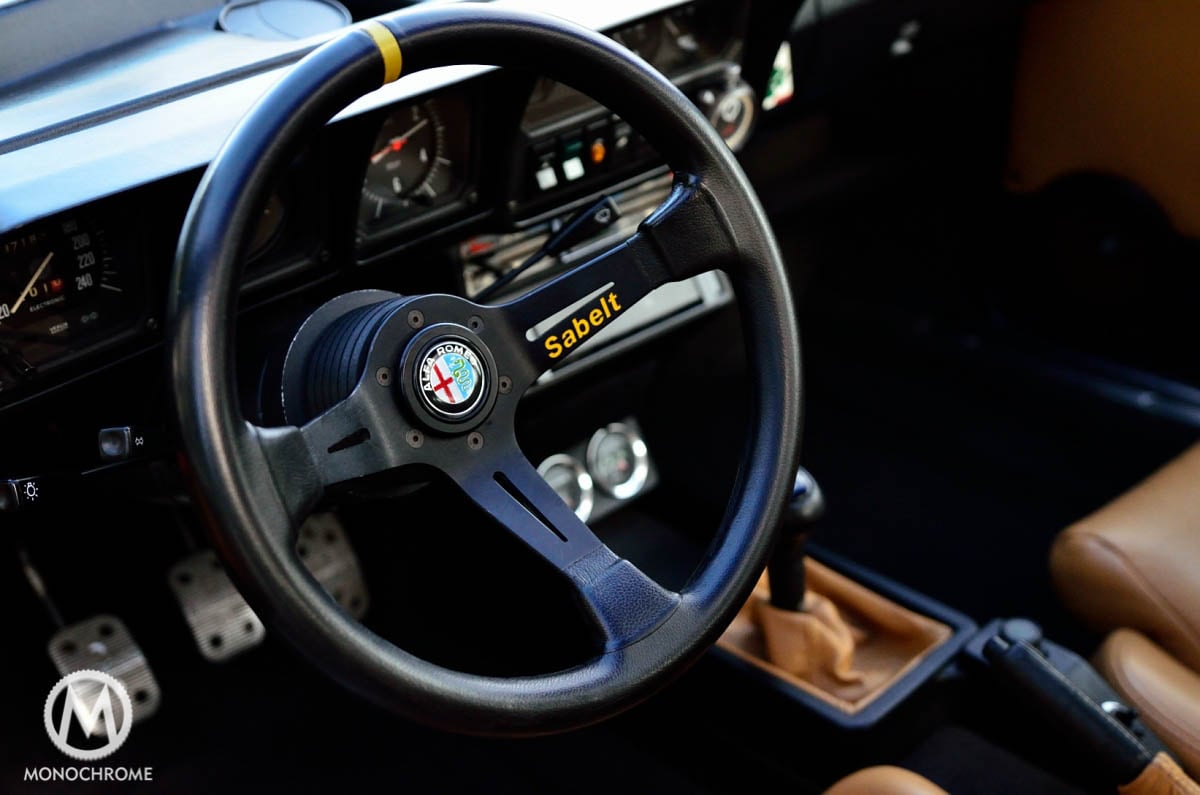
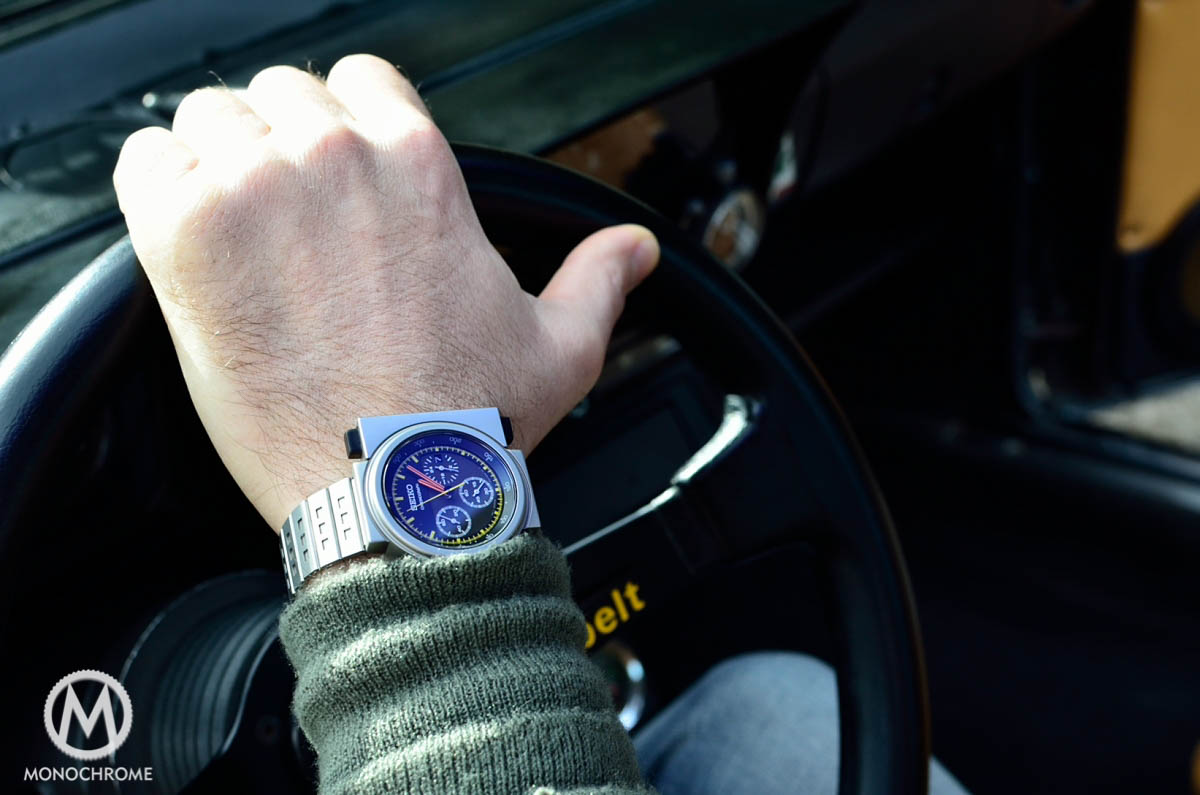
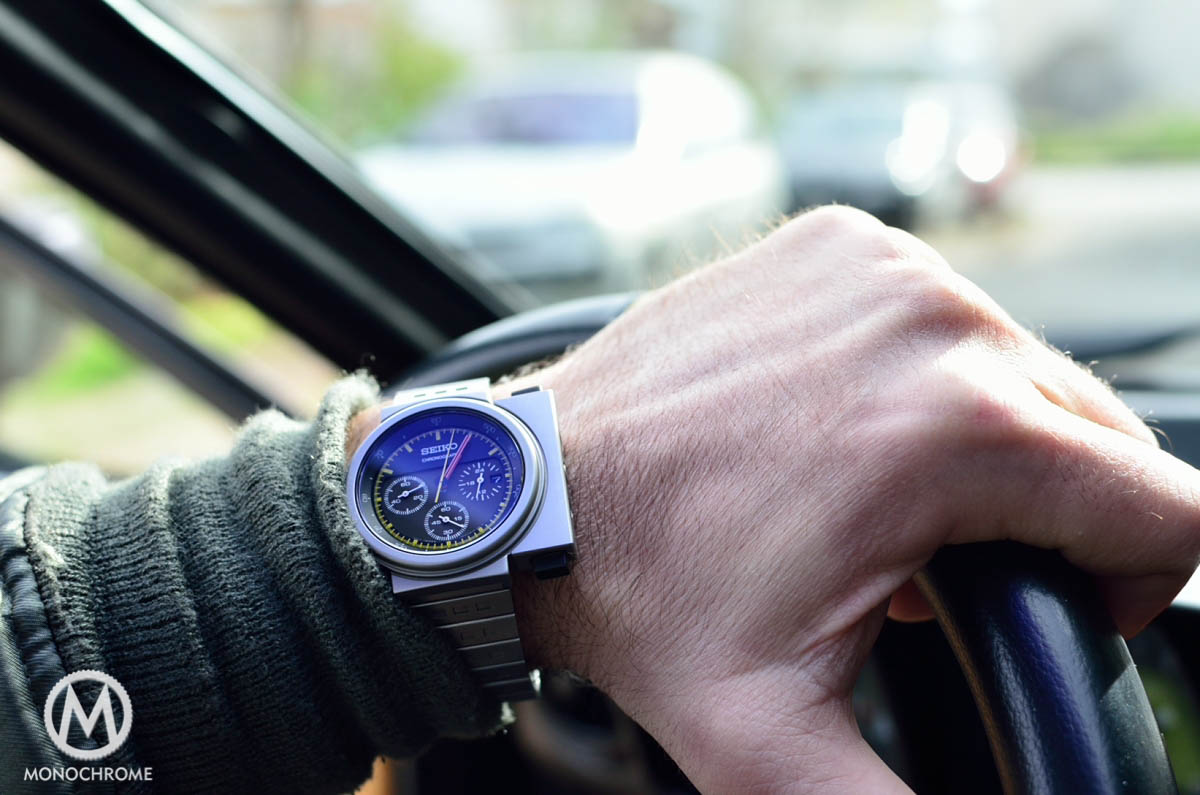
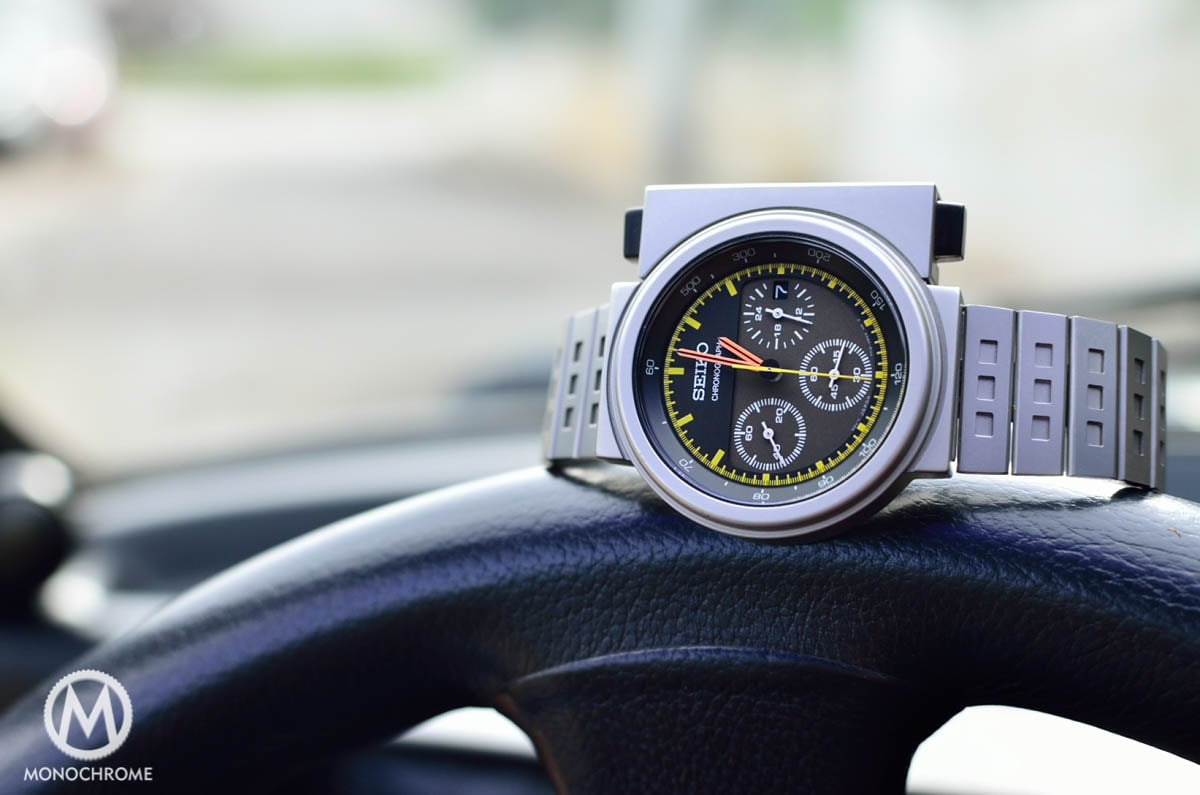
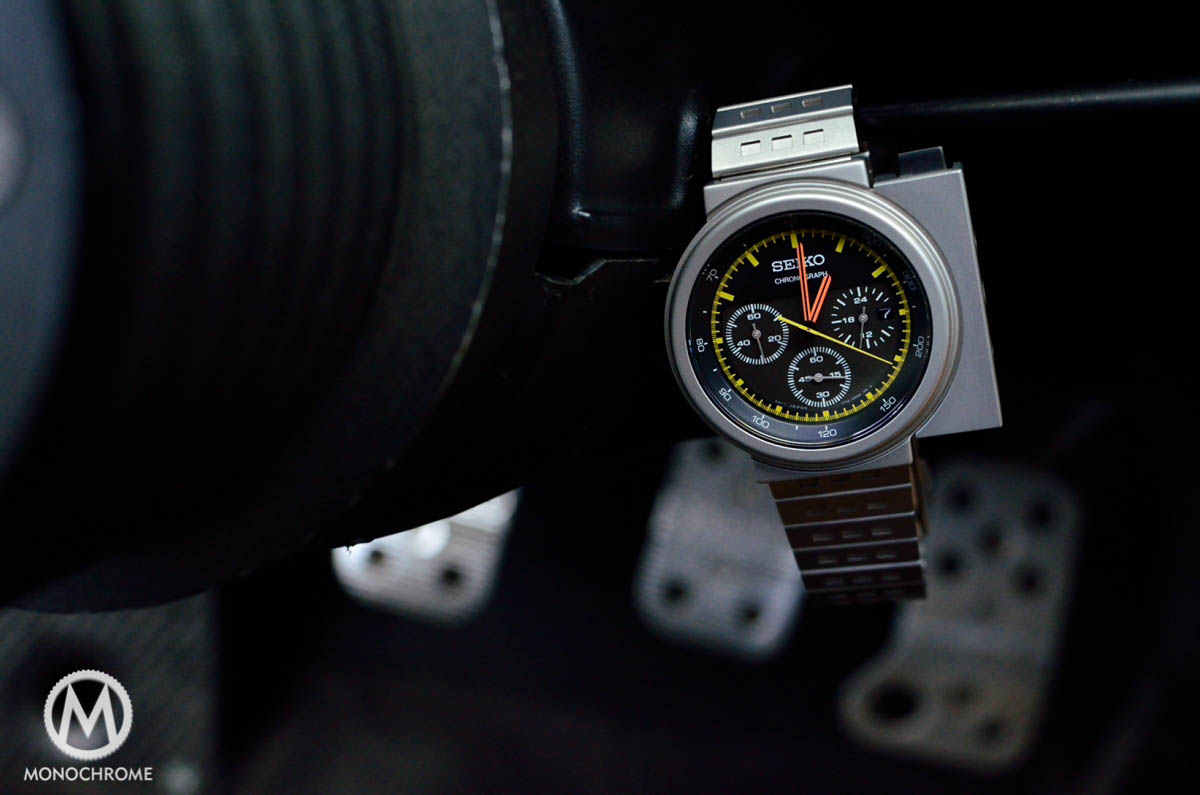
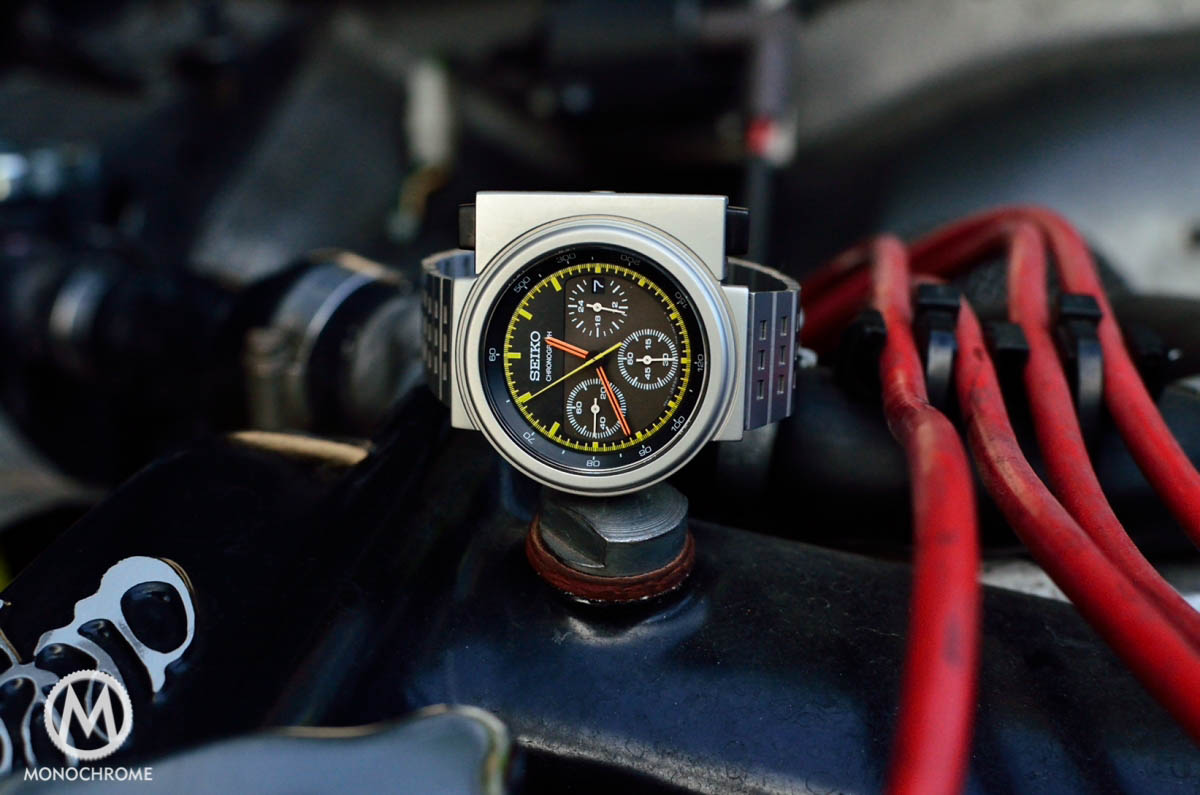
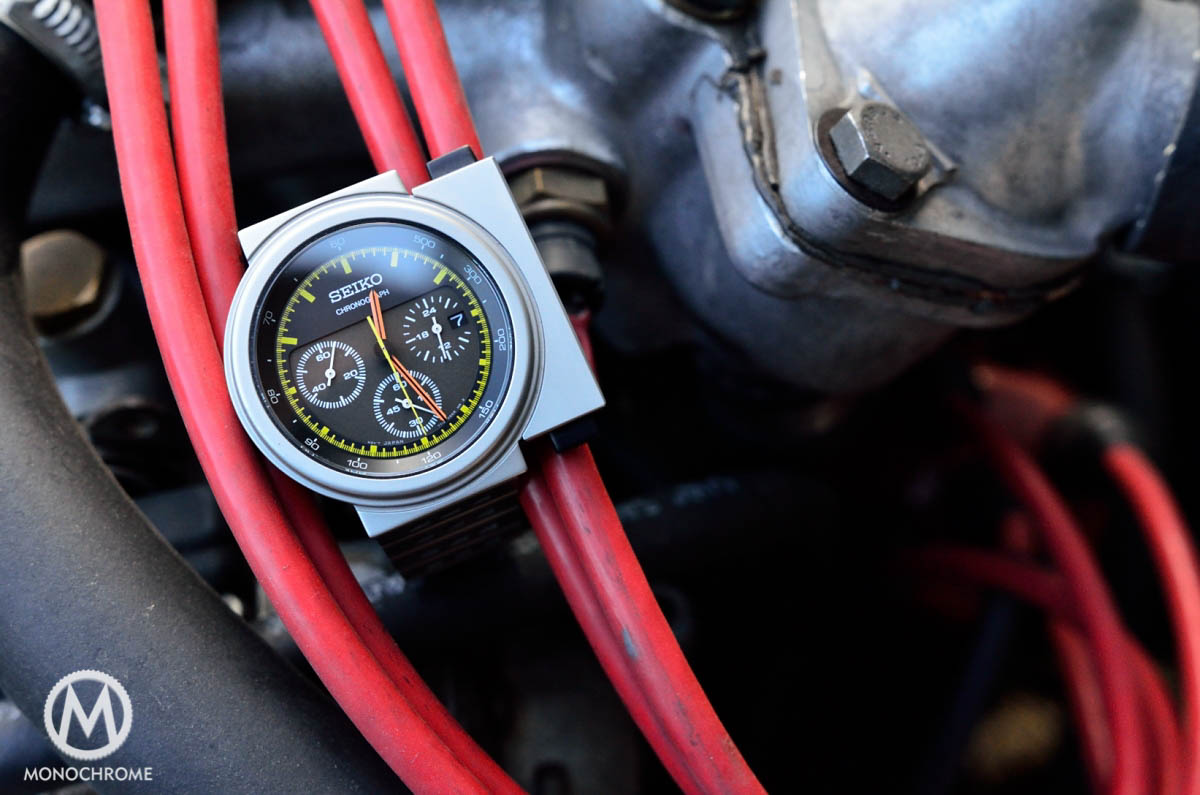

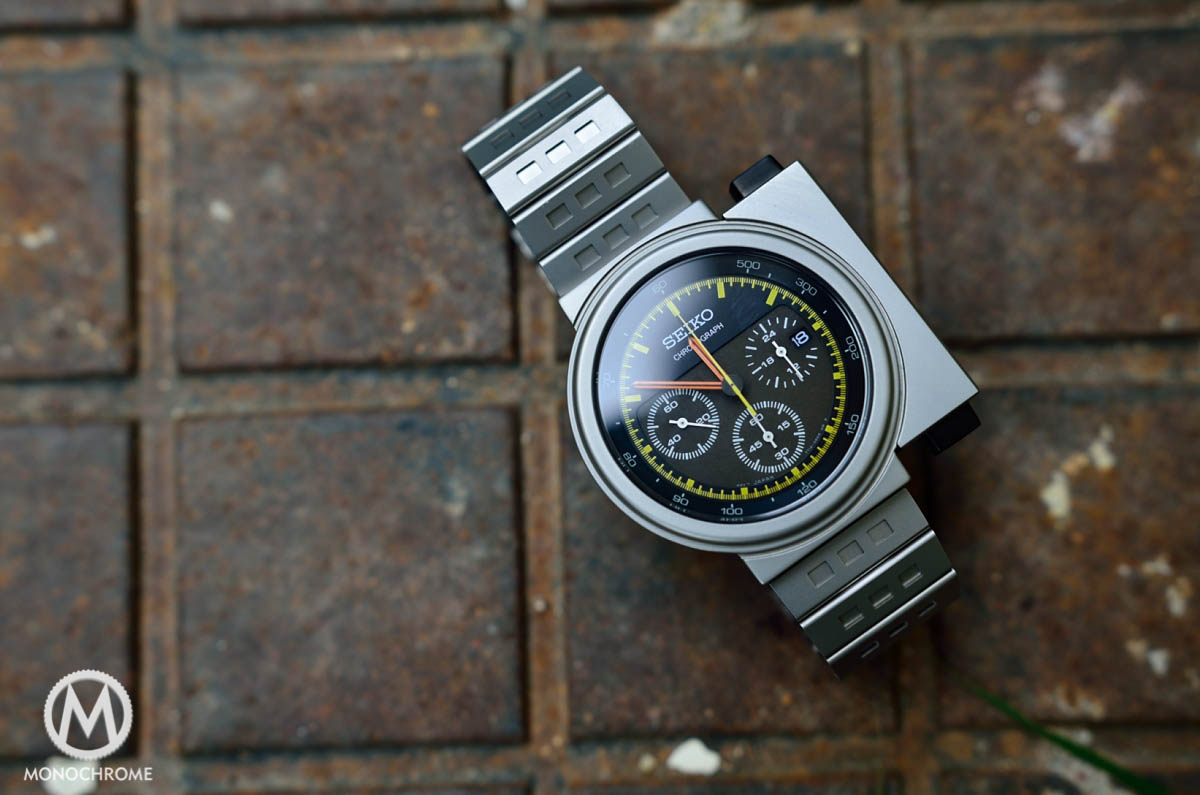
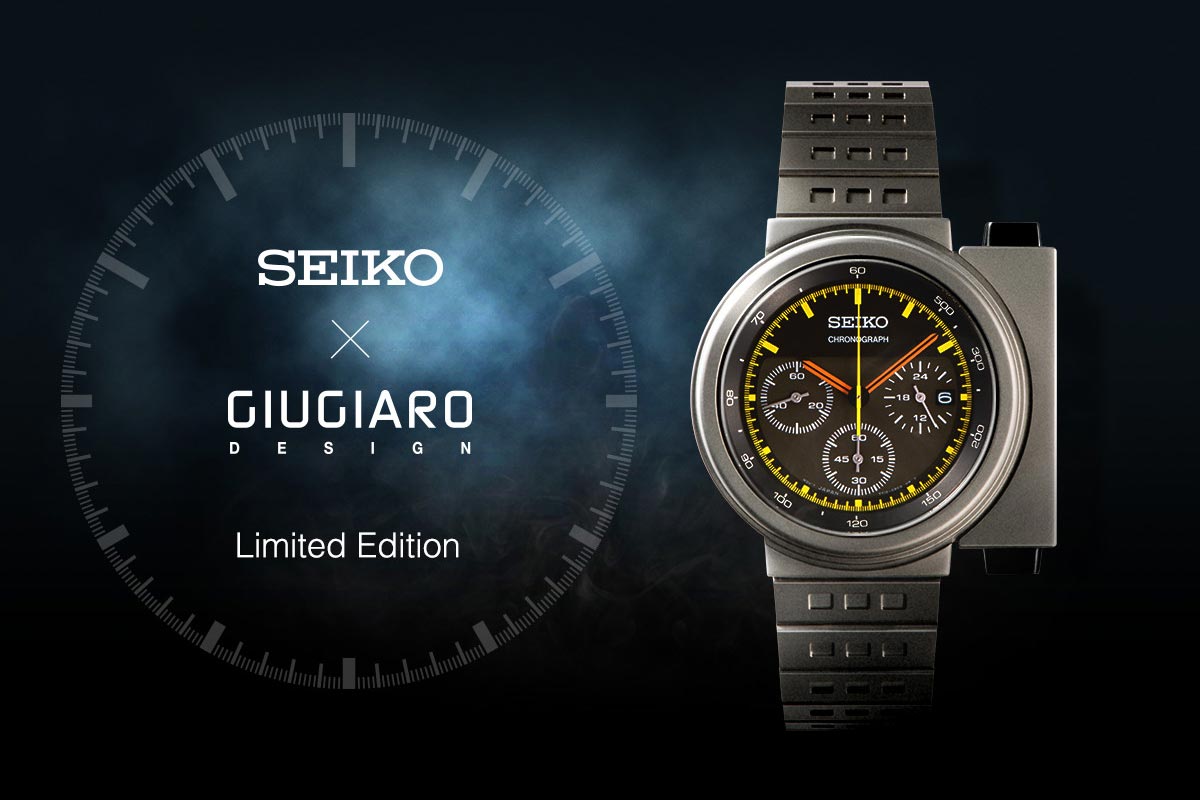



11 responses
As an alfa owner and watch lover this was a great write-up, thanks for sharing!
I would like to express my gratitude to Monochrome and Ilias Giannopoulos in particular for allowing me to write a few words about one of the big passions that fuel my life. Ilias, once again you have done an exquisite job. A huge thanks to you my Friend.
Zissis E. Akrivos
What a great article, I really enjoyed. Thanks
Sorry but the designer is Giorgietto GIUGIARO and not GUIGIARO. Only for your information. Best regards Mario
Giugiaro not Guigiaro please 😉
You have done an excellent job here. Congratulations. I remember staring Seiko Giugaro’s collection in my father’s shop’s windows and now I have the chamce to repair watches from that collection from time to time
The name will change. Just a typo error. Thanks to all for your nice words. 😀
Great article, but his name is really Giugiaro, not Guigiaro.
thanks, we corrected that typo!
Great review Mr. Giannopoulos… as always!
A truly unique timepiece for sure that one could say it came straight out of a contemporary desinger’s drawing board. One of it’s most charming characteristics if you ask me.
The coolest thing about this article though, is not only the review of the watch itself but also the background information about Giugiaro and design philosophy in general as well as his affiliation with Alfa Romeo in particular.
The thoughts of Mr. Akrivos where the cherry on the pie, as it is always so pleasant to read/discuss/share an aficionado’s knowledge of something so special, particularly when you can recognise true passion in every word of his. Most inspiring!
Thank you Gentlemen.
Amazing article of this great reissue.
As a big Seiko fan i enjoy reading to your great site for affortable watches of my favourite brand.